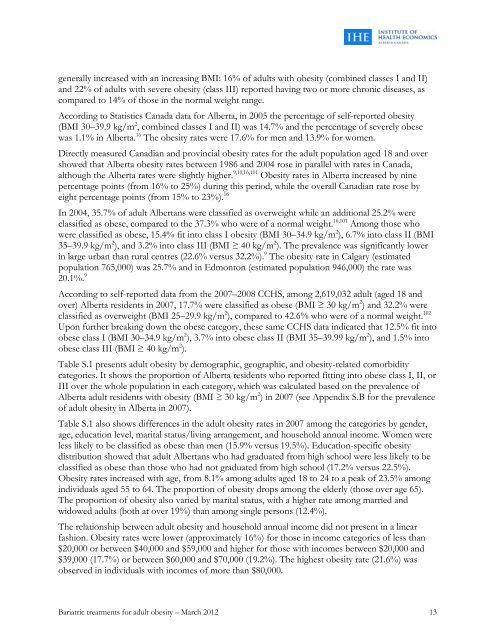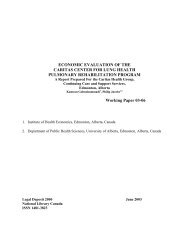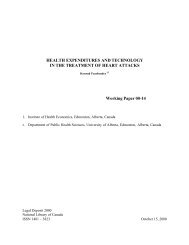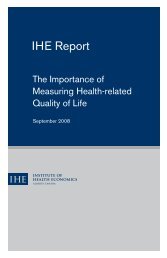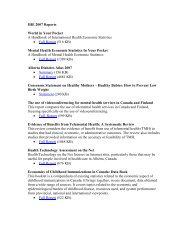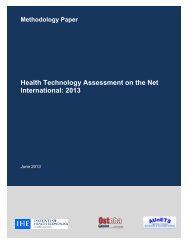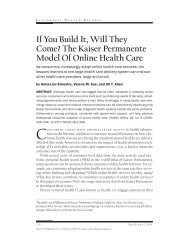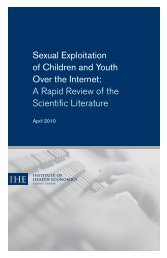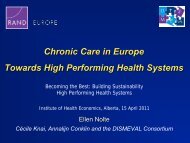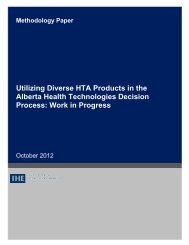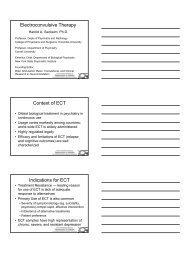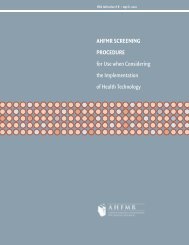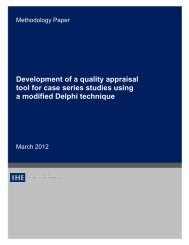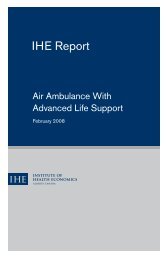Also using self-reported data from 2005 CCHS, Slater et al. 89 examined how overweight and <strong>obesity</strong>in Canadian <strong>adult</strong>s were distributed across socio-demographic and geographic groupings. Age,physical inactivity, education, non-immigrant status, white racial status, and moderate food insecuritypredicted varying degrees <strong>of</strong> overweight and <strong>obesity</strong> in both men and women. The highest <strong>obesity</strong>rates were observed in older age groups, among those who were physically inactive, white or nonimmigrant,with low educational levels, and living in the prairie and east coast regions. The lowestrates <strong>of</strong> <strong>obesity</strong> were observed in major urban centers. Although low rates <strong>of</strong> physical activity werepredictive <strong>of</strong> <strong>obesity</strong> <strong>for</strong> both genders, low consumption <strong>of</strong> fruits and vegetables was not associatedwith a higher BMI.Tjepkema analyzed directly measured data from the 2004 CCHS <strong>for</strong> specific characteristics,including physical activity and fruit and vegetable consumption, <strong>for</strong> those aged 18 and older, and<strong>for</strong>mal educational attainment <strong>for</strong> those aged 25 to 64. 29 Obesity was significantly related to diet andphysical exercise and it was generally inversely correlated with <strong>for</strong>mal educational attainment. Bothmen and women whose leisure time activities were largely sedentary were more likely to be obesethan those who were more physically active in their leisure time.Geographical variation in <strong>adult</strong> <strong>obesity</strong> in CanadaAccording to self-reported data from the 2007 CCHS, several provinces, including Alberta,Saskatchewan, Ontario, and Québec, have had an increase in their <strong>obesity</strong> rates between 2003 and2007, while rates in other provinces (Manitoba and Prince Edward Island) may be leveling <strong>of</strong>f ormay have decreased slightly (British Columbia, New Brunswick, Nova Scotia, and Newfoundlandand Labrador) in 2007 (www.statcan.gc.ca/daily-quotidien/080618/dq080618a-eng.htm). 88,98 Rates<strong>of</strong> <strong>obesity</strong> were highest in Saskatchewan, Alberta, and Atlantic Canada, ranging from 18% in Albertato a high <strong>of</strong> 22% in Newfoundland and Labrador. The lowest rates were in British Columbia where11% <strong>of</strong> <strong>adult</strong>s were classified as obese.Adult <strong>obesity</strong> in AlbertaSelf-reported and directly measured data have shown a steady increase <strong>for</strong> <strong>adult</strong> <strong>obesity</strong> prevalencein Alberta since 1986. 1,9,10,16,28,29,100 Schopflocher examined self-reported data from the 1996 NPHSand the 2001 and 2003 CCHS and reported that in 1996, 10.3% <strong>of</strong> <strong>adult</strong>s in Alberta (age 20 and over)were classified as obese (BMI 30–39.9 kg/m 2 , combined class I and II), and 1.6% as severely obese(BMI ≥ 40 kg/m 2 , class III). 28 In 2003, the percentages were 14.3% <strong>for</strong> <strong>adult</strong>s classified as obese(combined class I and II) and 3.2% <strong>for</strong> those classified as severely obese (class III). The ratesincreased with advancing age in both men and women until age 65 (with the highest rates seen inthose aged 55 to 64), after which there was a decline. The proportion <strong>of</strong> <strong>adult</strong>s classified as obese(combined class I and II) and severely obese increased in the lower income classes, although therewere differences in these rates between genders and within income groups. Rural <strong>obesity</strong> rates werehigher than urban rates, but the specific data were not given. Albertans without a secondaryeducation had higher levels <strong>of</strong> <strong>obesity</strong> than those having secondary education, some postsecondaryeducation, and college or university degrees.Schopflocher also correlated self-reported BMI in Alberta by health status, prevalence <strong>of</strong> chronicdiseases, and healthcare service utilization, using data from the 1996 NPHS and the 2001 and 2003CCHS. 28 He found that 12% <strong>of</strong> <strong>adult</strong>s with <strong>obesity</strong> (combined classes I and II) and 9% <strong>of</strong> those withsevere <strong>obesity</strong> (class III) reported having fair or poor health, as compared to 8% <strong>of</strong> the normalweightpopulation. The proportion <strong>of</strong> <strong>adult</strong>s diagnosed with one or more chronic conditions<strong>Bariatric</strong> <strong>treatments</strong> <strong>for</strong> <strong>adult</strong> <strong>obesity</strong> – March 2012 12
generally increased with an increasing BMI: 16% <strong>of</strong> <strong>adult</strong>s with <strong>obesity</strong> (combined classes I and II)and 22% <strong>of</strong> <strong>adult</strong>s with severe <strong>obesity</strong> (class III) reported having two or more chronic diseases, ascompared to 14% <strong>of</strong> those in the normal weight range.According to Statistics Canada data <strong>for</strong> Alberta, in 2005 the percentage <strong>of</strong> self-reported <strong>obesity</strong>(BMI 30–39.9 kg/m 2 , combined classes I and II) was 14.7% and the percentage <strong>of</strong> severely obesewas 1.1% in Alberta. 16 The <strong>obesity</strong> rates were 17.6% <strong>for</strong> men and 13.9% <strong>for</strong> women.Directly measured Canadian and provincial <strong>obesity</strong> rates <strong>for</strong> the <strong>adult</strong> population aged 18 and overshowed that Alberta <strong>obesity</strong> rates between 1986 and 2004 rose in parallel with rates in Canada,although the Alberta rates were slightly higher. 9,10,16,101 Obesity rates in Alberta increased by ninepercentage points (from 16% to 25%) during this period, while the overall Canadian rate rose byeight percentage points (from 15% to 23%). 16In 2004, 35.7% <strong>of</strong> <strong>adult</strong> Albertans were classified as overweight while an additional 25.2% wereclassified as obese, compared to the 37.3% who were <strong>of</strong> a normal weight. 16,101 Among those whowere classified as obese, 15.4% fit into class I <strong>obesity</strong> (BMI 30–34.9 kg/m 2 ), 6.7% into class II (BMI35–39.9 kg/m 2 ), and 3.2% into class III (BMI ≥ 40 kg/m 2 ). The prevalence was significantly lowerin large urban than rural centres (22.6% versus 32.2%). 9 The <strong>obesity</strong> rate in Calgary (estimatedpopulation 765,000) was 25.7% and in Edmonton (estimated population 946,000) the rate was20.1%. 9According to self-reported data from the 2007–2008 CCHS, among 2,619,032 <strong>adult</strong> (aged 18 andover) Alberta residents in 2007, 17.7% were classified as obese (BMI ≥ 30 kg/m 2 ) and 32.2% wereclassified as overweight (BMI 25–29.9 kg/m 2 ), compared to 42.6% who were <strong>of</strong> a normal weight. 102Upon further breaking down the obese category, these same CCHS data indicated that 12.5% fit intoobese class I (BMI 30–34.9 kg/m 2 ), 3.7% into obese class II (BMI 35–39.99 kg/m 2 ), and 1.5% intoobese class III (BMI ≥ 40 kg/m 2 ).Table S.1 presents <strong>adult</strong> <strong>obesity</strong> by demographic, geographic, and <strong>obesity</strong>-related comorbiditycategories. It shows the proportion <strong>of</strong> Alberta residents who reported fitting into obese class I, II, orIII over the whole population in each category, which was calculated based on the prevalence <strong>of</strong>Alberta <strong>adult</strong> residents with <strong>obesity</strong> (BMI ≥ 30 kg/m 2 ) in 2007 (see Appendix S.B <strong>for</strong> the prevalence<strong>of</strong> <strong>adult</strong> <strong>obesity</strong> in Alberta in 2007).Table S.1 also shows differences in the <strong>adult</strong> <strong>obesity</strong> rates in 2007 among the categories by gender,age, education level, marital status/living arrangement, and household annual income. Women wereless likely to be classified as obese than men (15.9% versus 19.5%). Education-specific <strong>obesity</strong>distribution showed that <strong>adult</strong> Albertans who had graduated from high school were less likely to beclassified as obese than those who had not graduated from high school (17.2% versus 22.5%).Obesity rates increased with age, from 8.1% among <strong>adult</strong>s aged 18 to 24 to a peak <strong>of</strong> 23.5% amongindividuals aged 55 to 64. The proportion <strong>of</strong> <strong>obesity</strong> drops among the elderly (those over age 65).The proportion <strong>of</strong> <strong>obesity</strong> also varied by marital status, with a higher rate among married andwidowed <strong>adult</strong>s (both at over 19%) than among single persons (12.4%).The relationship between <strong>adult</strong> <strong>obesity</strong> and household annual income did not present in a linearfashion. Obesity rates were lower (approximately 16%) <strong>for</strong> those in income categories <strong>of</strong> less than$20,000 or between $40,000 and $59,000 and higher <strong>for</strong> those with incomes between $20,000 and$39,000 (17.7%) or between $60,000 and $70,000 (19.2%). The highest <strong>obesity</strong> rate (21.6%) wasobserved in individuals with incomes <strong>of</strong> more than $80,000.<strong>Bariatric</strong> <strong>treatments</strong> <strong>for</strong> <strong>adult</strong> <strong>obesity</strong> – March 2012 13
- Page 1 and 2: Alberta STE ReportBariatric treatme
- Page 3 and 4: Alberta STE ReportBariatric treatme
- Page 5 and 6: EXECUTIVE SUMMARYSocial and System
- Page 7 and 8: Three surgical procedures—adjusta
- Page 9: Costs of Bariatric Surgery and Pote
- Page 12 and 13: Regulatory status .................
- Page 14 and 15: TABLES AND FIGURESSection One: Soci
- Page 16 and 17: ABBREVIATIONSAll abbreviations that
- Page 18 and 19: LYMmMAMDMUHCNANHLBINHSNICENIHNNHNPH
- Page 20 and 21: Bariatric physician: a licensed Doc
- Page 22 and 23: High-density lipoprotein (HDL): a f
- Page 24 and 25: Very-low-calorie diet (VLCD): a die
- Page 26 and 27: Additional Internet searches were c
- Page 28 and 29: This report addresses obesity in ad
- Page 30 and 31: Many systemic factors have been ide
- Page 32 and 33: Severe obesity is associated with d
- Page 34 and 35: eport their height and under-report
- Page 38 and 39: An examination of overall obesity d
- Page 40 and 41: Table S.2 presents the associationa
- Page 42 and 43: • have multiple focal points and
- Page 45 and 46: The main problem in any weight mana
- Page 47: food, and a negative body image. As
- Page 50 and 51: directly causes death. 61 To the ex
- Page 52 and 53: The addition of a selected pharmaco
- Page 54 and 55: lack of formal training in nutritio
- Page 56 and 57: slightly more likely to have prescr
- Page 58 and 59: selection criteria, have facilities
- Page 60 and 61: Barriers to using appropriate baria
- Page 62 and 63: Overview of adult obesityOver the p
- Page 64 and 65: the need for regular physical activ
- Page 66 and 67: phenylpropanolamine/25. Sibutramine
- Page 68 and 69: Complianceand AdherenceDemand andut
- Page 70 and 71: Aetna Clinical PolicyBulletinswww.a
- Page 72 and 73: Overweight 123,821 172,971 157,623
- Page 74 and 75: REFERENCES1. 2006 Canadian clinical
- Page 76 and 77: 34. Gostin LO. Fast and supersized:
- Page 78 and 79: 69. Klarenbach S, Padwal R, Wiebe N
- Page 80 and 81: 105. Hill JO, Thompson H, Wyatt H.
- Page 82 and 83: 141. Ross R, Bradshaw AJ. The futur
- Page 84 and 85: 172. Arkinson J, Ji H, Fallah S, Pe
- Page 86 and 87:
This section will address a set of
- Page 88 and 89:
dietary therapy is to reduce total
- Page 90 and 91:
Additional benefits of exercise ove
- Page 92 and 93:
medications that inhibit intestinal
- Page 94 and 95:
Rimonabant may be considered for pa
- Page 96 and 97:
Long-term complications are specifi
- Page 98 and 99:
Devices used for bariatric surgeryH
- Page 100 and 101:
Description of the Included Systema
- Page 102 and 103:
AEs for sibutramineAs compared to a
- Page 104 and 105:
Evidence on Efficacy/EffectivenessW
- Page 106 and 107:
Table T.7: Effects of behavioural t
- Page 108 and 109:
SurgeryDescription of the included
- Page 110 and 111:
follow-up time was 3 years. Results
- Page 112 and 113:
group as compared to the VBG group.
- Page 114 and 115:
The authors identified many methodo
- Page 116 and 117:
The investigators pointed out that
- Page 118 and 119:
approximately 3 to 5 kilograms. For
- Page 120 and 121:
for studies with a mean age of part
- Page 122 and 123:
Examining whether use of any of the
- Page 124 and 125:
Evidence from placebo-controlled cl
- Page 126 and 127:
colorectal or gastroesophageal or f
- Page 128 and 129:
Web of ScienceISI Interface License
- Page 130 and 131:
AMA Clinical PracticeGuidelineswww.
- Page 132 and 133:
critical appraisal of the included
- Page 134 and 135:
APPENDIX T.B: EXCLUDED STUDIESTable
- Page 136 and 137:
Padwal R, Li SK, Lau DC. Long-term
- Page 138 and 139:
Quality subsection 1: At least MEDL
- Page 140 and 141:
Quality subsection 5a:Study quality
- Page 142 and 143:
Partially reported: The study types
- Page 144 and 145:
Table T.C.1: Results of quality ass
- Page 146 and 147:
Table T.C.1: Results of quality ass
- Page 148 and 149:
APPENDIX T.D: CHARACTERISTICS OF SY
- Page 150 and 151:
Table T.D.1: Characteristics of the
- Page 152 and 153:
Table T.D.1: Characteristics of the
- Page 154 and 155:
Table T.D.2: Characteristics of the
- Page 156 and 157:
APPENDIX T.E: EVIDENCE TABLE ON SAF
- Page 158 and 159:
Serious surgical complicationsSurgi
- Page 160 and 161:
LSGmMAMDNAnssORQoLRCTRDRRRYGBSBPTGV
- Page 162 and 163:
Table T.F.1-2: Weight loss - Behavi
- Page 164 and 165:
Table T.F.1-4: Weight loss - Surger
- Page 166 and 167:
Table T.F.2: Quality of life (QoL)
- Page 168 and 169:
Curioni & Lourenco 2005 58Cholester
- Page 170 and 171:
Table T.F.3-3: Risk factors/comorbi
- Page 172 and 173:
Table T.F.3-5: Long-term effects of
- Page 174 and 175:
Maciejewski et al., 2005 65Avenell
- Page 176 and 177:
Table T.G.2: Effects of bariatric s
- Page 178 and 179:
Table T.G.4: Effects of bariatric s
- Page 180 and 181:
18. Cerulli J, Lomaestro BM, Malone
- Page 182 and 183:
50. Health Canada Drug Product Data
- Page 184 and 185:
SECTION THREE: ECONOMIC EVALUATIONC
- Page 186 and 187:
Definition of bariatric surgical pa
- Page 188 and 189:
etween surgical interventions, the
- Page 190 and 191:
concluded that adding orlistat to L
- Page 192 and 193:
Weight management program (WMP) ver
- Page 194 and 195:
groups. Compared with standard care
- Page 196 and 197:
Results from Analysis of Provincial
- Page 198 and 199:
DiscussionThe objectives of the eco
- Page 200 and 201:
surgical suites, and so on. The bud
- Page 202 and 203:
APPENDIX E.A: LITERATURE SEARCH SUM
- Page 204 and 205:
CRD Databases(DARE, HTA & NHS EED)h
- Page 206 and 207:
Web of ScienceISI Interface License
- Page 208 and 209:
NEOS Librarywww.library.ualberta.ca
- Page 210 and 211:
Table E.A.2: Evidence table of revi
- Page 212 and 213:
ResultHealth outcomesCostsMarginal
- Page 214 and 215:
CostsMarginal analysisThe cost anal
- Page 216 and 217:
Time Horizon/discount rateCurrency/
- Page 218 and 219:
Objectivestudy perspective: society
- Page 220 and 221:
ResultHealth outcomesCostsMarginal
- Page 222 and 223:
ResultHealth outcomesCostsMarginal
- Page 224 and 225:
S4Economic burden of obesityMean co
- Page 226 and 227:
15. Lacey LA, Wolf A, O'shea D, Ern
- Page 228 and 229:
Author Contribution StatementsPaula


